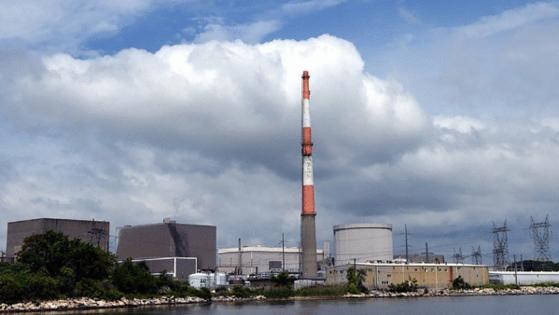Connecticut wants to be a 'climate leader' by 2050. It's not going to be easy as temperatures rise
Published in News & Features
Gov. Ned Lamont signed two landmark climate bills recently that set a goal for Connecticut to be carbon neutral by 2050 and to fortify the state’s infrastructure against severe weather, despite recent federal rollbacks that seek to dismantle nationwide carbon standards that have been in place for years, according to officials.
The new laws come after the release of the Environmental Quality in Connecticut report, which showed the state’s environmental status remains overall healthier than a decade ago. But several challenges remain, including the rapid spread of invasive species and the scourge of climate change increasing severe weather patterns, according to the report by the Council on Environmental Quality.
Senate Bill 9 bolsters climate resilience in infrastructure, its proponents said, while House Bill 5004 supports the renewable energy industry and sets a statewide net-zero carbon emissions goal by 2050.
The new bills, praised by environmental advocates, are aimed at slowing the effects of climate change. Scientists say carbon dioxide is the primary greenhouse gas contributing to climate change and that the burning of fossil fuels has significantly increased atmospheric carbon dioxide levels, trapping more heat and causing global temperatures to rise.
Officials say the most significant danger to Connecticut’s environment remains climate change as the state gets warmer and dryer on average, according to the report. The shift in climate also means more frequent severe weather events and more tolerable conditions for invasive species to thrive in the state.
Temperatures in Connecticut are rising, with the average temperature for 2024 above the average annual temperature of approximately 50 degree Fahrenheit, according to the report. Last year, 23 days saw temperatures greater than 90°F. The number of days with high temperatures was 52% greater than the average from 1960 to present.
“Connecticut is proud to be a climate leader and this legislation helps keep our state on track to improve our air quality and meet our climate goals,” Governor Lamont said in a press release. “Notably, it increases the tools available in our state that will attract business growth in the clean energy sector and the associated jobs that they support.”
In 2024, 44,190 thousand megawatt-hours of electricity was generated in the state by carbon-based fuel technology, with 17,844 megawatt-hours produced through zero-carbon technology, according to the state’s Department of Energy and Environmental Protection. The amount of zero-carbon electricity generated in the state comprised 40.4% of the total amount of electricity generated, which was a relative increase of 3.7% from 2023.
Yet despite the improvement in zero-carbon technology, the state’s goal of being fully carbon neutral by 2050 remains ambitious. The state that has only reached existing emissions goals one time, when people were staying home more in 2020, according to officials. Other challenges the state will have to contend with include the federal rollback of environmental protections and the loss of funding for climate change research and mitigation.
The federal cuts and rollbacks include halting work on the National Climate Assessment, considered one of the most critical sources of information about how climate change affects the U.S. Last month, the Environmental Protection Agency said that it will aim to eliminate existing limits on greenhouse gas emissions from coal and gas-fired power plants, a move that would curb the agency’s ability to combat climate change under the Clean Air Act.
The signing also came around the same time Republicans in the U.S. Senate approved the “One Big, Beautiful Bill,” which includes ending tax credits for clean energy projects not in service by 2027 — a move environmental advocates say could cripple the clean energy sector and is a major win for fossil fuels. The bill cleared the House of Representatives on Thursday and was signed by President Donald Trump on the 4th of July holiday.
Despite the federal pushbacks, advocates say the new bill offers incentives for those switching to renewable energies, including a renewed push for thermal energy. Officials say they hope the new legislation will make Connecticut a more attractive place for the renewable energy market, as renewable energy companies may seek out more environmentally friendly states.
“HB 5004 is a step in the right direction to get Connecticut back on track toward meeting our climate goals and reclaiming our role as a climate leader in the region,” said Julianna McVeigh, climate and resilience campaign manager at Save the Sound. “We hope that this bill is one piece in a larger puzzle of climate legislation that will be passed this session.”
The other bill signed by Lamont seeks to harden the state’s infrastructure against severe weather. The bill seeks to improve transparency about flood risk by requiring flood risk disclosure when someone is buying a home and ensuring that insurance companies inform people that average policies do not include flood coverage, according to officials. The bill also improves planning for residential development by requiring coastal site plan review for construction of single-family homes in areas facing sea level rise, proponents say.
Last year saw a number of extreme weather events in Connecticut from historic rainfall and flooding to months of drought conditions causing dozens of wildfires to break out across the state. According to Federal Emergency Management Agency officials, more than $10 million in federal disaster assistance was approved last year for thousands of Connecticut households damaged in a historic August rainfall that brought fast moving flood waters.
History was made again during the fall season amid an unusually dry spell that shattered records. The drought led to fire weather conditions that burned several hundred acres of forests across the state, exhausting firefighters as they battled the blazes. The Hawthorne fire, one of the largest wildfires in Connecticut in decades, took the life of a Wethersfield firefighter and consumed over 100 acres of forest on Lamentation Mountain at its peak.
©2025 Hartford Courant. Visit at courant.com. Distributed by Tribune Content Agency, LLC.







Comments